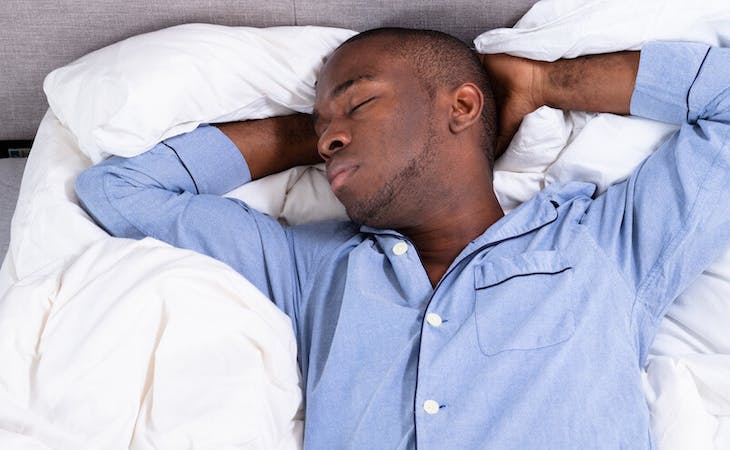Most experts agree that back sleeping is the best position for your body to sleep in. The thing is, only about 8% of people are actually back sleepers.
Although side sleeping is the most common sleep position (and is a good option if you have acid reflux or sleep apnea), it does come with some downsides. Namely, side sleeping can put pressure on your hips, shoulders, and neck and cause back pain.
Stomach sleeping, meanwhile, is something most experts just don’t recommend at all. Stomach sleepers have to keep their head turned to be able to breathe. The 90-degree rotation of your head can put additional stress on the joints, ligaments, tendons, muscles, and nerves in your neck and upper thoracic spine.
If you’re a side or stomach sleeper who deals with pain and discomfort at night, then you may want to consider making the switch to back sleeping.
Here, learn all about the benefits of back sleeping—plus, find out how to sleep on your back if it’s not something you’re in the habit of doing.
How to train yourself to sleep on your back in 5 easy steps
Changing up your sleep position and learning how to sleep in a new position can be difficult at first. But it’s well worth it if you’re continually waking up with back and neck pain in the morning.
Sleeping on your back is the ideal neutral position for your body throughout the night. Back sleeping is also one of the best sleeping positions to help cut down on lower back pain and neck pain.
Luckily, there are a few things you can do to make the transition easier. Try the following tips to train yourself to sleep on your back so you can start experiencing a good night’s sleep.
1. Choose the right mattress
The best mattress for back sleepers is typically a medium-firm mattress. Anything too soft may cause you to sink into the bed, while anything too firm may put pressure on your shoulders and back.
2. Find a supportive pillow
Beyond your mattress, the right pillow is also key. The best pillow for back sleepers is a thinner to medium-thick pillow. This will help keep your head, neck, and spine properly aligned.
3. Address your back pain
If you experience back pain, try sleeping on your back with a small pillow under your knees to help maintain the natural curve of your lower back, support your hip flexors, and relieve discomfort.
A wedge pillow is a great way to help your body adjust to a new position and help you get comfortable sleeping. Stretching before bed can also help alleviate and prevent nighttime back pain.
4. Keep yourself in place
When all else fails, break out the pillows so you physically can’t roll onto your side or stomach. For example, put pillows on both sides of your body and one under your knees to prevent them from flipping over.
This is a great way to train your body into new sleeping habits. Eventually, your body will get used to sleeping in a new position and you’ll be able to get comfortable sleeping face-up.
5. Be patient
Transitioning from stomach or side to back sleeping won’t happen overnight. Each of the tweaks you make may take weeks to get used to.
There may also be a period of trial and error where you figure out what works best for you. But if you give yourself time to get used to your new sleep position, you’ll eventually be rewarded with healthier sleep.
Benefits of sleeping on your back
Back sleeping is ideal because it both keeps your head and spine in alignment, eliminating the pressure that contributes to aches and pains, and allows your back muscles to relax.
This position is also excellent for people who complain of back pain and tightness. For people with acid reflux and heartburn, this position works well because it keeps your head above your airway. However, to have your head elevated correctly, you need the right pillow or adjustable bed.
Sleeping on your back helps prevent acne by keeping your face away from your pillowcase. Additionally, back sleepers are less prone to sleep wrinkles. Stomach and side sleepers often wake up with creases on the side of the face they lie on. These creases can cause wrinkles on your face over time.
Best types of mattresses for back sleepers
Part of training yourself to sleep on your back includes finding the right mattress. You already know that a medium-firm mattress is ideal for back sleepers—now it’s time to consider the mattress type.
Innerspring, hybrid, memory foam, and latex foam mattresses can all be good options for back sleepers—but there are a few things you’ll want to keep in mind when selecting a new mattress.
Above all, you want a mattress that provides a balance of comfort and support for your upper body and lower body. Both memory foam and latex foam contour to your body and cradle your spine. This contouring ability can make memory foam and latex particularly comfortable for back sleepers.
However, some back sleepers find that memory foam has too much give, causing you to “sink in.” In that case, a latex mattress or a hybrid mattress with a foam comfort layer for extra cushioning might be a better option.
Frequently asked questions
Should pregnant women sleep on their back?
Back sleeping may not be the most comfortable or safest for you during pregnancy. When you sleep on your back, there’s a risk of compressing the aorta, the main artery in your body. This can lead to decreased blood flow to your heart and uterus and cause dizziness or even fainting.
It’s best to sleep on your side during pregnancy—and ideally your left side to reduce the risk of cutting blood flow back to your heart. Placing one or two pillows between your legs or under your abdomen may help you sleep more comfortably during your third trimester.
How long does it take to train yourself to sleep on your back?
Training yourself to sleep on your back can vary greatly from person to person. But it’s safe to say this change likely won’t happen overnight. It may take you a few weeks up to a few months to find what works for you.
Try sleeping on your back every night during the transition period to get yourself used to sleeping in this position. That said, if you give back sleeping a fair chance and find that you just can’t get a good night’s sleep, then you may want to reconsider because sacrificing sleep quality can be detrimental.
Start sleeping better with a new mattress from Saatva
Back sleeping is the healthiest sleep position for many people—it can help reduce back pain, relieve sinus buildup, and prevent sleep wrinkles. Overall, it’s healthy to train yourself to sleep on your back.
Saatva offers a wide variety of mattresses and bed accessories to help you get comfortable while learning to sleep on your back. Take our online mattress quiz to find the best mattress for your sleep style and ideal position. All of our mattresses come with a 365-night home trial and industry-leading warranty.






